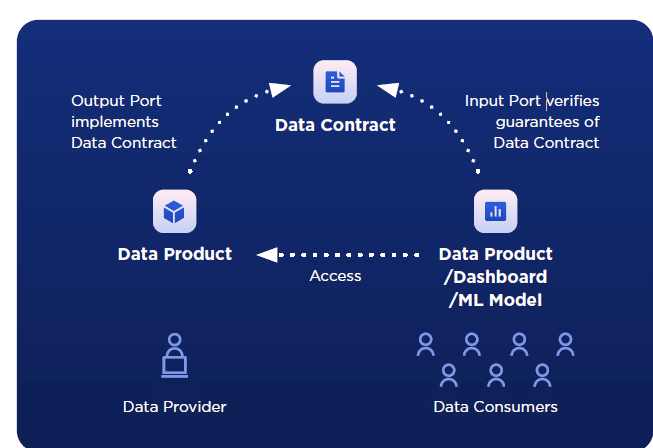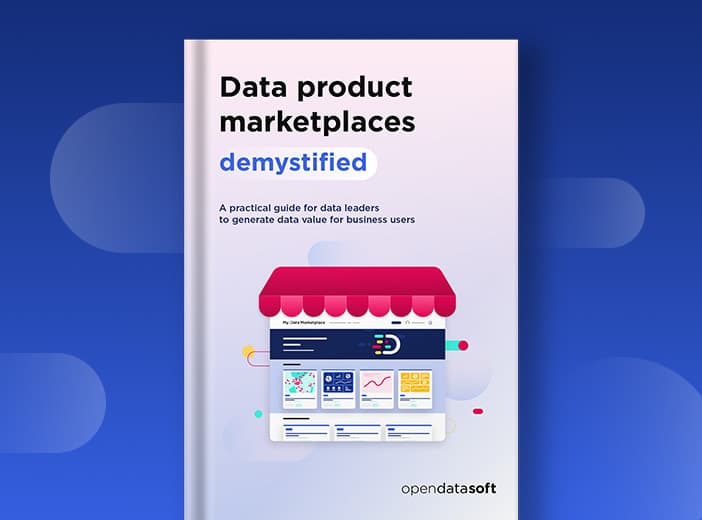Why data contracts and data product marketplaces are essential to increasing data value

Data contracts are key to building trust in data in distributed environments, and are at the heart of data products. We look at how to build and enforce data contracts through a data product marketplace to unlock greater value from data.
To drive increased usage, data has to be both easy to consume and be trusted by business users. Only then will it deliver real value for the organization and realize overall investment in the data stack.
Creating and sharing data products through a data product marketplace ensures that data is ready to consume and meets business needs. Data contracts embedded within data products and enforced through the data product marketplace build trust between human and AI data consumers and data producers, providing guarantees and service level agreements (SLAs) around data reliability, quality and how data can be used.
Data contracts are therefore critical to unlocking data value – this blog explains what they are, and how they work within a data product marketplace to drive and scale seamless sharing and collaboration around data.
Understanding data contracts
A data contract is a formal agreement that defines how data is structured, formatted, and communicated between different components of a data system. It is normally created in the industry-standard YAML format to ensure compatibility and consistency, with the same template used across an organization.
What does a data contract contain?
A data contract normally covers these key areas:
- Data schema: This explains how the data is structured, organized and formatted. Schema definitions may involve specifying which formats, structures (e.g., Avro or JSON), and data types will be used.
- Data semantics: The contract must outline what the data means and how it should be interpreted by users. This needs to be clear for non-technical, business users.
- Data quality: This explains and provides guarantees on how accurate, complete and consistent the supplied data will be. This should include often it is updated and levels of reliability and accuracy. The contract can explain how data quality is validated and measured.
- Terms of Use: Consumers need to understand how the data can be used, accessed or shared. Producers need to specify who can access it, and for which purposes. This supports robust data governance, security and regulatory compliance.
- Service Level Agreements (SLAs): There need to be clear guarantees around data freshness – i.e. how often it is delivered, along with interface quality.
The data contract contains output and input ports. An input port describes the data a consumer expects (format, structure, rules), while an output port describes the data a producer provides. The contract links the two to ensure that the data exchanged meets expectations.
Creating data contracts should be a collaborative, ongoing process between all stakeholders. That means involving data producers and architects, governance teams, and above all the end users that will be consuming the data. Everyone must be clear on the terms within the contract and be confident that they meet their needs. There should be clear feedback loops to ensure that any issues are quickly overcome, improving the data contract on an ongoing basis.
Where are data contracts used?
Organizations now operate in a world that is full of data, distributed across multiple internal and external systems. That means that data consumers and data producers may not have a direct relationship or even work for the same company. Data contracts are therefore vital to mandate and manage how data is shared, and what both parties can expect from specific data assets. They provide context and guarantees to enable confident data sharing in distributed data architectures. By delivering a common understanding around data, they minimize ambiguity, reduce integration costs, enhance collaboration and enforce data quality and consistency.
Common data contract use cases include:
- Real-time systems which automatically exchange data, often at high speed, such as financial trading solutions. They provide both providers and consumers with the guarantees that data will meet requirements and not negatively impact their own systems. Other examples of real-time systems include in healthcare and supply chain operations.
- Data pipelines which automate data flows between different systems. Data contracts define the format, structure, and quality of data moving between systems, reducing risk and automating transfers.
- Data products. A data product is a specific, high-value category of data asset that meets a defined, long-term business need and is easily consumable by a large potential user base. Data contracts guarantee data quality, format and reliability and therefore encourage consumption. This blog provides more details on what a data product covers.
When it comes to data products, data contracts are essential to building trust. Just as a contract between a buyer and a seller on a consumer e-commerce marketplace encourages people to buy products from vendors they have no direct relationship with, a data contract within a data product provides similar guarantees that encourage usage.
Data contracts provide end users with a precise agreement regarding what the data product owner intends to deliver and how the data product should then be used, building trust between all parties.
Data contracts are published along with the data product on the marketplace, so that it can be understood by data consumers, and must be both machine- and human-readable to underpin AI models. Given that data products can be replaced or updated as business needs change over time, this must be reflected within their contracts.

Enforcing data contracts through a data product marketplace
A data product marketplace provides a single, centralized, self-service space for all of an organization’s data assets, automating their delivery, availability and consumption. Just like an e-commerce marketplace, it showcases data products and other data assets, promoting them and encouraging their consumption through an intuitive, user-focused experience. Data product marketplaces are designed specifically to meet the needs of data producers, consumers, and governance teams, and have to be:
- Scalable, to cope with increasing data volumes and user needs
- Secure to ensure compliance and good governance
- User-centric to drive adoption by non-technical employees
- Easy and seamless to administer
Data contracts to ensure trust
Essentially data product marketplaces provide a complete collaboration platform for producers and consumers of data products. Trust is vital between everyone involved. Without it, consumers will not be confident in what data products cover and how they can use them, while data producers and governance teams will worry about data being accessed and consumed by the unauthorized audiences, impacting governance and compliance.
Embedding data contracts within data products, and enforcing these through the data product marketplace is therefore essential. All of this scales data consumption, delivering key benefits around increased efficiency, better-informed decision-making, lower risk, greater innovation and greater productivity.
Increasing data value through data contracts
Chief Data Officers (CDOs) recognize the imperative to turn their growing data volumes into business advantage, increasing consumption and value by sharing information in understandable, usable ways across the organization. The combination of data products and data product marketplaces provide the foundation for seamlessly sharing data to drive value. Within these data contracts are essential to building trust between consumers and producers, increasing usage and guaranteeing governance to maximize data value.
Find out more about turning data into value through data product marketplaces in our new, practical guide. Aimed at CDOs and other data leaders it includes best practice and real-world examples to accelerate data consumption. Download your copy here.

In today’s data-driven world, many organizations struggle to scale data consumption, with their data scattered across multiple systems, making it hard to access, understand, and leverage effectively. How can organizations transform this raw data into value, enabling it to drive decision-making, innovation, and AI adoption? This practical guide helps Chief Data Officers (CDOs) and data leaders to transform their data strategy and meet their goals by implementing self-service data product marketplaces.

Data product marketplaces empower businesses and data leaders with the ability to industrialize data sharing and consumption to create data value. We look at the key foundations you need to put in place to ensure your data product marketplace successfully generates value, increases usage and drives ROI.

It can be hard to understand exactly what a data product is, given the many ways that the term is defined and applied. To provide clarity this article provides a business-focused definition of a data product, centered on how it makes data accessible and usable by the wider organization, while creating long-term business value.
